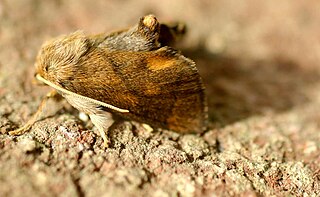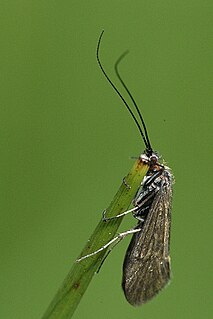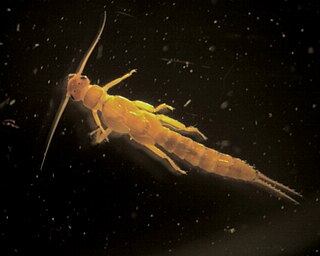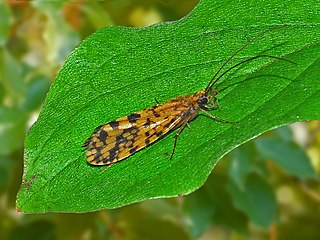
A pupa is the life stage of some insects undergoing transformation between immature and mature stages. Insects that go through a pupal stage are holometabolous: they go through four distinct stages in their life cycle, the stages thereof being egg, larva, pupa, and imago. The processes of entering and completing the pupal stage are controlled by the insect's hormones, especially juvenile hormone, prothoracicotropic hormone, and ecdysone. The act of becoming a pupa is called pupation, and the act of emerging from the pupal case is called eclosion or emergence.

The Luna moth is a Nearctic moth in the family Saturniidae, subfamily Saturniinae, a group commonly known as giant silk moths. It has lime-green colored wings and a white body. The larvae (caterpillars) are also green. Typically, it has a wingspan of roughly 114 mm (4.5 in), but can exceed 178 mm (7.0 in), making it one of the larger moths in North America. Across Canada, it has one generation per year, with the winged adults appearing in late May or early June, whereas farther south it will have two or even three generations per year, the first appearance as early as March in southern parts of the United States.

The caddisflies, or order Trichoptera, are a group of insects with aquatic larvae and terrestrial adults. There are approximately 14,500 described species, most of which can be divided into the suborders Integripalpia and Annulipalpia on the basis of the adult mouthparts. Integripalpian larvae construct a portable casing to protect themselves as they move around looking for food, while Annulipalpian larvae make themselves a fixed retreat in which they remain, waiting for food to come to them. The affinities of the small third suborder Spicipalpia are unclear, and molecular analysis suggests it may not be monophyletic. Also called sedge-flies or rail-flies, the adults are small moth-like insects with two pairs of hairy membranous wings. They are closely related to the Lepidoptera which have scales on their wings; the two orders together form the superorder Amphiesmenoptera.

Dobsonflies are a subfamily of insects, Corydalinae, part of the Megalopteran family Corydalidae. The larvae are aquatic, living in streams, and the adults are often found along streams as well. The nine genera of dobsonflies are distributed in the Americas, Asia, and South Africa.

Limnephilidae is a family of caddisflies with about 100 genera. They belong to the main lineage of case-constructing caddisflies, the Integripalpia or tube-case caddisflies. The Limnephilidae is one of the most species-rich Trichoptera families of northern temperate regions, but only a few are known from tropical areas and the Southern Hemisphere. For this reason they are often known as northern caddisflies.

The Limacodidae or Eucleidae are a family of moths in the superfamily Zygaenoidea or the Cossoidea; the placement is in dispute. They are often called slug moths because their caterpillars bear a distinct resemblance to slugs. They are also called cup moths because of the shape of their cocoons.

Actias isis is a moth of the family Saturniidae first described by Léon Sonthonnax in 1899.

The Hydropsychidae are a family-level taxon consisting of net-spinning caddisflies. Hydropsychids are common among much of the world's streams, and a few species occupy the shorelines of freshwater lakes. Larvae of the hydropsychids construct nets at the open ends of their dwellings which are responsible for their "net-spinning caddisfly" common name.

The Ecnomidae are a family of caddisflies comprising 9 genera with a total of 375 species.

The Psychomyiidae are a family of tube-making caddisflies. Members of this family are typically very similar to polycentropodids, most of them can be differentiated by the spur formula is 2-4-4, thyridial cell short, absence of the forewing fork I, and hindwing forks I and IV. Male genitalia has elongate preanal appendages, and reduced tergum IX. The larvae differ by the submental sclerites separated, foretrochantin broad, and the pupal mandible apex whip-like. Larvae construct long silken galleries.

Philopotamidae is a family of insects in the order Trichoptera, the caddisflies. They are known commonly as the finger-net caddisflies.
The Glossosomatidae are a family of the class Insecta and order Trichoptera.The family contains 23 genera in three subfamilies. In the US alone, there are 76 spp. in 6 different genera.
Hubert Duprat is a French artist known for his unusual work, an artistic intersection between caddisfly larvae and gold, opal, turquoise and other precious stones.

Agriotypinae is a subfamily of ichneumonid parasitoid wasps found in the Palaearctic region. This subfamily contains only one genus, Agriotypus. The known species are aquatic idiobiont ectoparasitoids of Trichoptera pupae.

Arsenura armida, the giant silk moth, is a moth of the family Saturniidae. It is found mainly in South and Central America, from Mexico to Bolivia, and Ecuador to south-eastern Brazil. It was first described by Pieter Cramer in 1779.

Chloroperlidae are a family of stoneflies, commonly known as green stoneflies, with more than 200 species and 22 genera. They appear green to yellow in colour, and are popularly used among fisherman as bait for trout fishing. Green stoneflies live in the benthic zone of the cold streams and rivers of five continents and four zoogeographical regions, emerging from the water to live in the riparian zone as adults. They are sensitive to pollutants, making them an indicator species for determining the quality of water bodies. Chloroperlidae are hemimetabolous, having no pupal stage, but instead hatch from eggs as nymphs and mature directly into adults. They are omnivorous, feeding on small organisms and plant particles, and become more carnivorous as they mature. The classification of Chloroperlidae is contested, with some believing that they should be considered as members of different orders, as opposed to the order Plecoptera that they currently belong to.
Cyclotorna monocentra is a moth of the family Cyclotornidae. It is found in Australia.

Eucheira socialis, commonly known as the Madrone butterfly is a lepidopteran that belongs to the family Pieridae. It was first described by Westwood in 1834. Locally known as Mariposa del madroño or tzauhquiocuilin, it is endemic to the highlands of Mexico, and exclusively relies on the Madrone as a host-plant. The species is of considerable interest to lepidopterists due to gregarious nest-building in the larval stages, and heavily male biased sex ratio. It takes an entire year for this adult butterfly to develop from an egg. The eggs are laid in the month of June and the adults emerge the following May–June. The adults have a black and white pattern on their wings, and the males are generally much smaller and paler than the females. The larvae do not undergo diapause and continue to feed and grow communally in the coldest months of the year. There are two subspecies of E. socialis, named E. socialis socialis and E. socialis westwoodi.
Dicosmoecus gilvipes is a species of northern caddisfly in the family Limnephilidae. This particular caddisfly is found in and near streams of North America, from northern California and Colorado to British Columbia and as eastern to Nevada, Idaho, Montana and Alberta. D. gilvipes is commonly known as the October Caddis, Autumn Caddis or Giant Orange Sedge, due to their flying presence acknowledged in the Autumn. Caddisflies are known to build cases when they are in larvae stages, to protect themselves from predators, such as dragonflies, salmon and trout. The October Caddisfly is no different and builds their cases out of different organic materials during their five larvae stages.

Philopotamus montanus, common name yellow spotted sedge, is a species of caddisfly belonging to the family Philopotamidae.















